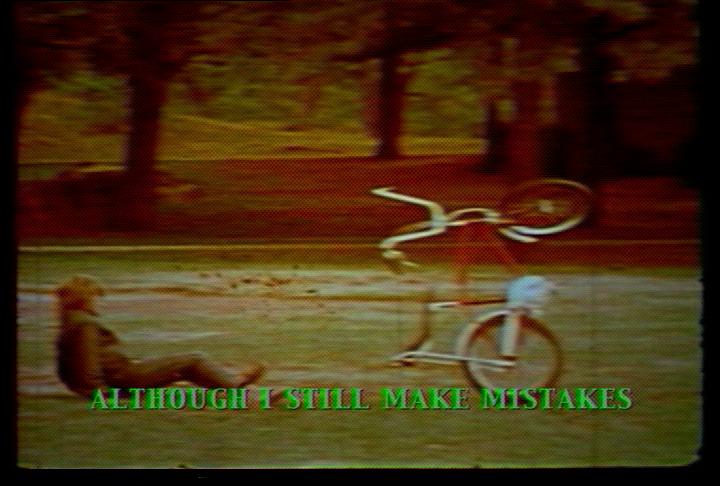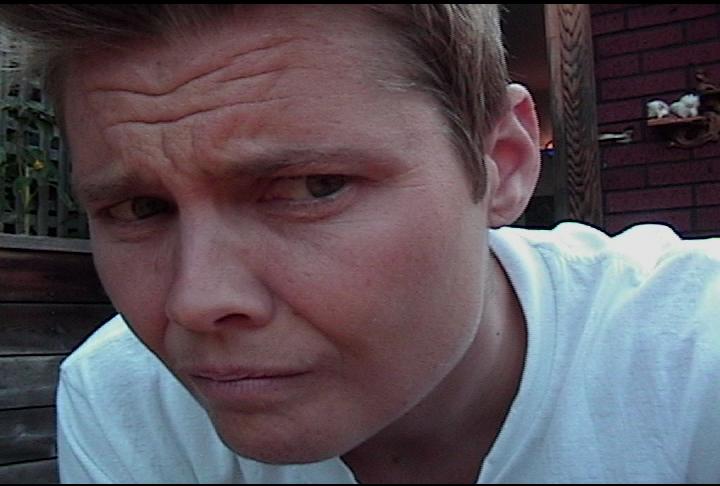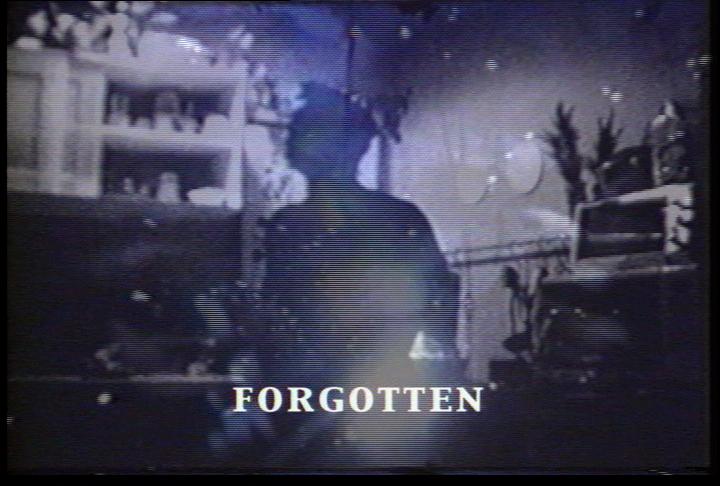Setup/Punchline/Repeat: Deirdre Logue...
here’s a new kind of close-up for us to deal with now–no longer the enormous landscape of movie faces, sculpted by expensive lighting and practiced emotion. Now we have the near ones, real-time and real size, detailed resolution not of dense grain but of high-definition pixels, faces free of artifice… or at least relatively so, and willing to reveal any artifice they do have. They do not look off-screen in search or service of some axis, but their sidelong eye-line does go towards our surrogate, the camera-mirrored viewfinder. It’s an axis with only one end, the new subjective intimacy, when we know she’s not looking at us, she’s looking at herself.
Of course it would be this way. Have you ever tried playing a scene looking directly into the camera lens? It’s a cold impersonal thing and it gives nothing back (there’s a reason Errol Morris was compelled to invent the Interrotron). It’s much easier to look an inch to your right (camera left) and see your own face, which holds all the fascination of those extended moments that you can spend trapped in your own bathroom-mirror eyes. You can perform easily to this face. It’s your own, you know it better than anyone else–from the inside, anyway. When viewed from the outside, it’s more a stranger to you than to the others. This problem of inside/outside, of you the familiar stranger, is the endless fascination of the mirror, of the viewfinder, and to record your own face caught in the act of this fascination… well, how could that fascination not transmit itself to the viewers of this record? And what a gift (to them) that would be.
That’s the idea, anyway.
But what’s to prevent these moments from turning back into landscape, or, if not large enough to be landscape then dioramas, a series of frozen tableaux well-schooled in a shorthand of poses, static gestures, attitudes? Already the face-cam intimacy has grown familiar. What could be more revealing than showing my flaws in close-up… and then at least showing how I hide the other ones, the ones I don’t want to reveal? This is a diorama, a prefab cube (one face cut away, for viewing from outside) containing store-bought poses, cheaply made plastic limbs pointing at each other in good-natured self-critical acknowledgement.
Is all this not just a little too easy?
And also: What is it anyway, about Woody Allen? His flaws, his virility… mostly his flaws, but those end where the movie ends, whereas his virility extends beyond the bounds of the frame. Pity me for my flaws, love me out of pity–and poof! A disappearing act. His movies make of him an effigy, soliciting your affection for his endearing failings–failings you see as your own—and then the effigy is burned away. The flaws are gone but your love remains. The neurotic has martyred himself for the cause, and his libido sticks around to reap the benefits.
Deconstructing Harry was meant to put an end to all of this; though not his final film it certainly felt terminal at the time. This time the effigy was already incinerated before the first frame, nothing of Woody left to love. This time he was all misanthropic bile, spouting invective in language we’d never before heard pass the lips of even his most unsavoury characters, buying the indulgence of sexual fetishes he’d previously only euphemistically joked about. Self-centered as always, but now padlocked shut. This is the real me, the film seemed to say, this is what I’ve fooled you into loving for all these years, but things are winding down now and I’ve decided, out of mercy or generosity or maybe just fatigue, to call an end to this game. This ugly honesty, better late than never, was his gift to us.
That was the idea, anyway. But once the spectacle of selfishness had faded from our eyes, there arose the feeling that he’d escaped again. Once past the initial and by no means insignificant bravery of displaying himself as botched beyond redemption, he was then able to sneak out of the onscreen body, taking refuge in the role of displayer. That’s the benefit of casting yourself in this type of diorama: if it’s well wrought and close up and unpleasantly detailed enough, you are impervious to any criticism because you’ve already leveled them all at yourself. And the suspicion remains that perhaps his deck was stacked, that perhaps this too was just a little too easy.
The process of distasteful self-revelation, though at first negating affection, ends up bringing our pleasant feeling back to bear—just on the director, not the character. The warm-fuzzy machine, once it’s set in motion, is pretty hard to stop.
Woody Allen thought he would make his terminal movie. But he couldn’t. The Terminal Age, if it ever existed, is over. We’re living in the time of the loop. It began as a simpler idea, an ideal, which embraced rhythm, meter and regularity. Strike tympani with mallet. Repeat. Each strike was a different moment in time, similar but different. Identical pictures in identical frames must still occupy different spots on the wall.
This idea, however, becomes untenable in a world in which representation of time-based events is so slickly accurate as to be indistinguishable from the real thing. It’s a world in which one no longer need strike the drum regularly; a single shot will suffice for the sample to be looped ad infinitum into a pulse, whatever beat you like. Is it any wonder that, in a world such as this, obsessive-compulsion is a normal mode of activity, an acceptably worthy-of-investigation behaviour phenomenon? No moment too small, no action too brief! It seems so easy to loop things and make them… something. A little too easy.
(But are we perhaps overly concerned with effort? One way or another it’s a criterion. Perhaps we marvel that the artist “makes it look so easy.” Or perhaps, on the other hand, her strains of effort are so pronounced, the resultant howl so shriekishly strained, that we cannot doubt her difficulty. Or on a third hand–this is maybe the newest form of our attitude to artistic effort, an attitude made widely possible by the camcorder—we are overjoyed to see that a certain result can be achieved with no more work than we ourselves would be capable of putting in. And so a certain kind of video art propagates itself.)
You can loop with edits, blowing up a moment to enormity and importance, or you can do it with performance, making yourself a loop. Deirdre Logue in Why Always Instead of Just Sometimes does it both ways, loops inside and outside, a tactic which seems in this case born of something not so much like fashion, sometimes like ease, but often enough like necessity.
She writes onscreen: “Although I still make mistakes, I have found more people to blame.” That is to say, as Woody Allen would say: Here, look at my problem. It’s a problem, which, if you find yourself in my proximity, may well result in my inflicting pain on you. But I am not apologizing. I am merely telling you a specific way in which I am bad. And you will probably see that you are similarly bad, and in this way I will solicit your affection. But Woody didn’t say it; Deirdre did. And her iteration carries a little less of the Manhattan-cuddly neurosis, a little more of the Toronto-loop terror.
In Deconstructing Harry Woody was soliciting not our love (lost cause, that) but our admiration. The film forsakes humanity to strive for grandeur. Grandeur need not be large in scale; it need only be final in tone. This is a common implicit artistic goal: to create an artifact so fully epitomizing the medium/genre as to render all prior artifacts obsolete, all future ones superfluous. There is an attempt to make this the last one. This will be the summit of its type. That Woody made this terminal vocation explicit in a film through which he sought to also end himself is a fortuitous marriage of ambitions. Deirdre and her video occupy a similar betrothal, each side looking for its better half, hoping not so much to find it as to put an end to looking, to itself.
Worry is a loop, a few seconds’ worth of super 8 footage emblazoned with a cyclical paean to cyclical neurosis: “I AM 38 YEARS OLD/AND SOMETIMES/I WORRY SO MUCH/I WORRY/IT WILL KILL ME.” This is worthy of Woody Allen (and/or vice versa)–but that would be late Woody Allen, i.e. the one that tried to end himself. It’s a punch line but-in addition to being more sad, or maybe frightening, than funny, (depending on how much of yourself you see in it (i.e. how “inside” you are))–it’s a punch line that leads back to the setup. And it’s worth noting that, if you take it as discrete phrases rather than a continuum–and piece-by-piece is how it appears onscreen in this linear experience to which we all, humans and videos alike, seem to be tethered—you can make it less frighteningly loopy (though more frighteningly final): “I worry so much. I worry. It will kill me.” No cause-and-effect chain of potential problem there, just a series of three definites. Interestingly, if the text is viewed in that way, there is a strangely lingering assertion, no longer a phrase conducting one thought to another but now an impossibly autonomous syntactic artifact: “And sometimes.” And it looms like some sort of blade.
A stunt-boy’s failed Wheelie plunks him on his ass in an explosion of dirt and shame; viewed once, it’s slapstick, which is to say: a pathetic and surprisingly unique instance of an individual’s encounter with a particularly uncooperative particular piece of time and space. That moment, sampled and looped, becomes something else: something abstract (okay, not nonrepresentational, but abstract in any and every other meaningful way), obviously no longer bound to any set of space-time coordinates and therefore no longer real. No longer pathetic, now it’s Pathos. This past event (past in two ways: in that it has already occurred, and in that it has now ceased to be an event) is now a beat, ready for the infusion of significance, the superimposition of a melody (or, more likely, a riff). Significance is often achieved via juxtaposition, e.g. incongruous music (itself also likely looped) and/or onscreen text.
Beyond the Usual Limits, part 1: Prying apart cushions, mattresses, and other domestic items made to fit together softly but neatly; hoping for a handful of change, or jewelry, or a secret message; this is quite familiar to me (and, I imagine, to plenty who are not me). What I hadn’t quite realized I wanted until I saw it–or rather, what I knew I wanted but had never known exactly what it looked like–was the search gone deep, head and shoulders swallowed whole by the crack between mattress and boxspring, the rest of the body pushing itself to soon follow. She doesn’t imagine–for us, for herself, for anybody–what’s on the other side. She even left a piece of fuzzy sentience behind and like all cats she doesn’t seem to care. From over here where I am, where all the rest of us are, it looks like an act of self-erasure. And I understand that that would probably be fine with her.
“Did you hear that?” she says in Eclipse, and at first I suppose the sound is all in her head, and her grimaces seem the effects of some emotional anguish and/or oddball cognition that we will never access. But it turns out they’re not effects. They’re causes, means to an end, and the end is one of those noises (the cracking of a jawbone, evidence of internal flaws and fault lines) that, being produced by one’s head, rarely makes it outside, much less to others’ ears. But in this rare moment–duly fabricated, of course, like those other, giant close-ups of yore, but with night vision video in place of Technicolor—the trip from in to out is a successful one. Never mind the fabrication, and never mind that the fascination we’re feeling is a prefab shadow, a reflection of her own fascination with her viewfinder; it made it from her to us, from inside to out. Some sort of accomplishment, then, this. Like all successful movies big and small, new and old, it generates a real intimacy from the ashes of a false one. Are we in any position to ask for more?
Beyond the Usual Limits, part 3: The skin is the most usual limit of them all, and Deirdre’s tried to exceed hers by tracing its interior contours from the outside. In the climax she paints her own ear black; unhappy with the limit of her own perimeter, her only recourse is the erasure of that very boundary, or at least a permanent marker of the attempt. (The ear, remember, is one of those few places on the body where the demarcation between inside and outside is not reducible to a two-dimensional or even an epidermal border, i.e. it’s one of the places where the outside gets in.) And all the while, a synthetic beat loops itself from the speakers to our ears. The goal of Deirdre’s limit-surpassing activities is never clear, self-liberation and self-annihilation are equally plausible. But this time, the task complete, the ear blackened, something happens—actually, un-happens: time throws itself into reverse and the black paint disappears to re-reveal the again-unsullied skin. This makes nothing clearer but it does throw things into relief, the same way the moment of reversal is accompanied on the soundtrack by a new timbral element, not disturbing the beat but re-contextualizing it, moving us from the pathetic to the aesthetic. That this moment provides the feel of catharsis, though without the usual attendant narrative understanding, is some sort of gift. We still don’t know where she went when she disappeared beyond the mattress, but for an instant we know what it felt like. And we see that perhaps it was transcendence not because she escaped but because getting there made her realize it was time to come back.
I once (only once) made a video which, supposedly questioned the ease (and regularity) with which digital video artists can (and do) flip the switch and reverse time, or at least footage. Someone told me they thought it seemed too easy and I didn’t realize it was a criticism. But if I had, I would have said in my defense that I was questioning the ease (and regularity) with which digital video artists et cetera… and how easy a defense that is.
It’s so important that I express myself, isn’t it? That I give you a sense of myself? That’s really the main thing, that’s the goal. If I do that, then I’ve won. I thought I’d like to try writing this while watching Deirdre’s tape, but the damn loops and beats and pictures, even the ones that are practically static, occupy my attention. It’s something electric, and we know that the electric is neither alive nor real; it’s fake because it’s immortal.
Sometimes this repetition is enough to make you howl. But we don’t howl, do we? I don’t, anyhow, and neither does Deirdre. We have this other method, where we encase our whispers in little boxes and then blow the boxes up bigger than life, so we can parse the cracks and gaps in between our own whispersounds.
Have you ever had a moment of crisis on the dance floor? I’ll bet Deirdre knows what I’m talking about: you find the groove, you fall into a four-limb step that perfectly epitomizes the way in which this song is rocking the joint. And then something happens: it might be the sideways glance of some girl you thought was digging you but who you now realize holds your body’s motion in coldly amused contempt; or it might just be your own realization that you’ve been making the same pattern of moves for some time now, and you can’t just stop and start something new, because that would contravene imperatives both inside and outside. You’re going to have to slowly, subtly, suavely mutate this you and loop into a new, better one. That’s your best bet for a way out, you think over and over, as the Smiths (#2 most-common name in the world, I once read) sing I am human and I need to be loved, and you keep trying to assert and broadcast your individuality and unique manner of physical congruence with the song, just like everybody else does. At a certain point, once you’re past the second chorus, this is inevitable.
Deirdre Logue may not be inevitable, but her video is. Like most motion pictures that we give ourselves these days, it’s symptomatic. It has little interest in self-diagnosis—indeed, how could a symptom diagnose itself? Symptoms can only be noted. Or, in the case of a highly uncommon symptom, it can note itself. This symptom is indeed interested in something, which—not always, but sometimes—exceeds simple notation. It hopes against hope (which is to say: against itself) for either a profound mutation or a lancing. At its bedraggled best it pries itself apart, crawls deep inside, into the crack, and looks for change.





